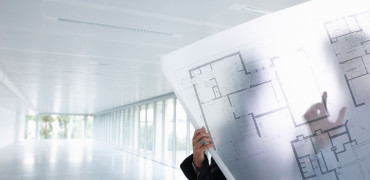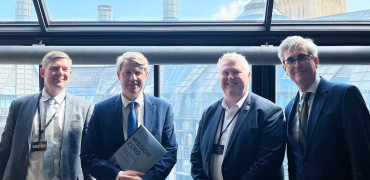The need to focus on the whole lifecycle of a building has become a major part of the net zero conversation as the construction industry looks for ways to reduce carbon emissions.
The UK’s major contractors are all now looking at the impact of construction on both their own business and the wider community, and this has seen many of them ask suppliers for net zero plans and verification of carbon emissions and sustainability.
This is not surprising as buildings contribute around 40% of greenhouse gas emissions. It’s therefore critical that everyone involved in the construction and operation of buildings, from architects, engineers, and other construction professionals understand the role they need to play in reducing the sector’s carbon footprint.
Building services or HVAC (Heating, Ventilation and Air Conditioning) are major consumers of energy in those buildings and, as a manufacturer of the equipment that keeps buildings at the right temperatures for occupants, we’ve been having more and more discussions with major construction companies than ever before.
Do you have all the documentation to prove you comply?
6 key areas to focus on
At Mitsubishi Electric we have long understood that it is only by harnessing the power of the collective wisdom within the construction supply chain, we can find ways to significantly reduce emissions and increase efficiency.
We therefore try to share as much of our knowledge as widely as possible and I’ve tried to simplify the things that the construction suppliers need to know into the 6 key issues.
- Sustainable Practices
- Safety and Risk Management
- Prefabrication and Modular Construction
- Materials and Techniques
- Product Support
- Wider ESG issues
Sustainable Practices
In addition to asking suppliers for verification of net zero and carbon reduction policies, the larger companies are also asking for innovative ideas to increase efficiency and drive sustainable growth.
This is because they realise that no one company can solve the climate crisis on their own, and the answer must lie in collaboration.
This is where innovations that promote environmentally friendly construction techniques, resource optimisation, waste reduction, and low-carbon solutions should be shared and celebrated.
Safety and Risk Management
Construction companies are also looking for ideas that enhance site safety, help with risk assessments, as well as mitigation strategies that can protect staff, assets, and the company’s reputation.
The third edition of Health and Safety in Construction explains the essential tasks for achieving healthy and safe construction sites.
It is aimed at everybody involved in construction work, including clients, designers, contractors and individual workers. Clients, designers and others who specify construction work may also find the book useful.
It helps the reader to identify hazards and control risks and explains how to plan, organise, control, monitor and review health and safety throughout the life of a project.
Prefabrication and Modular Construction
The recent news has been full of stories of schools being shut over safety concerns, which seemed to bring into question modular construction techniques. However, this piece in New Civil Engineer seems to place the responsibility on the contractor in many cases rather than the prefabrication process.
One thing is certain though, as we look more at decarbonising construction, carbon-intense material such as concrete, and our reliance on ‘dry weather’ construction face questions as never before.
Not only can modular construction create more jobs in factories, thereby increasing opportunities in construction for females and the less-able bodied, the assembly methods can significantly accelerate construction timelines and improve quality control.
Materials and Techniques
I’ve already touched on the need to find alternatives to cement above, and we even had George Clarke writing about it on the Hub here.
It no longer makes sense to use so many wet trades in construction, in ways that are so reliant on the unreliable British weather.
The same applies to many of the materials we traditionally use, so we have to find new materials, new building techniques, and creative applications that can enhance not only the durability of a building but also the functionality and the aesthetics while taking into account sustainability.
We can also learn from the past as this Hub article from Kirsty Hammond on the use of wood shows.
Product Support
At Mitsubishi Electric we have long embraced the idea of including as much information about our products as possible, to allow people to make an informed choice.
We were one of the first to use COP (Coefficient of Performance) as a measure of performance, and the first to advocate using SCOP (Seasonal COP) to show the real-life performance of equipment.
We are also the first manufacturer to include embodied carbon for our products and, in a long line of CPD Guides, our latest cover embodied carbon, wholelife carbon and operational carbon.
We have also tried to help installers and building operators stay ahead of changing F-GAS legislation affecting heating and cooling equipment.
Wider ESG
Wherever you sit in the construction supply chain, reducing the environmental impacts of the built environment has become a priority given the climate crisis we all face.
Major customers are demanding evidence of this from suppliers and it is unlikely to stop there.
They are also expecting companies to play their part in ESG (Environmental, Social and Governance) issues and this is because they themselves are being asked about these by their key stakeholders and investors.
It is therefore a global issue affecting everyone from small construction suppliers to major international brands, and it doesn’t just cover carbon reduction and net zero plans. It also needs to factor in your recycling policies, your engagement with the local community and your overall levels of compliance with the obvious and not so obvious, such as modern slavery.
So, the way you apply yourself to the non-financial factors of your business and how you can demonstrate this to your customers will help them to identify material risks and help ensure that you are part of their growth plans.
Conclusion
Do you know your existing carbon footprint for example? How involved are you with your local community? Do you have all the documentation to prove you comply with all necessary business requirements?
One way you can begin this journey is by starting to review things and this is why we as a business are now offering our customers the opportunity to become an accredited Committed Carbon Reduction Partner (CCRP).
We’ve extended the invite to all partners throughout the HVAC industry to help them embark on their own journey towards net zero.
To get involved, partners can email our Partner Programme Team – Partner@meuk.mee.com.
Danielle Cordner, Construction Business Development Manager




